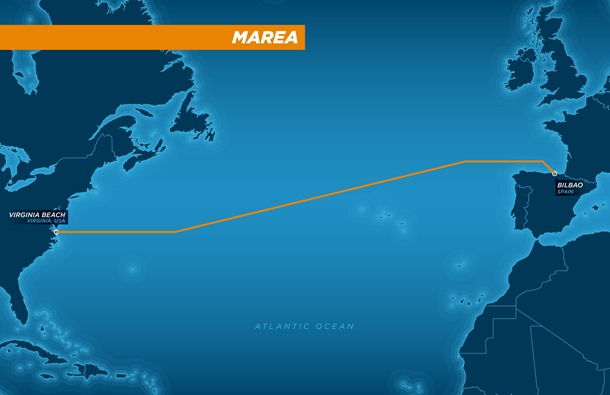
Announcing the plan on Thursday, the pair said the cable will help meet growing customer demand for high speed, reliable connections for their plethora of cloud and online services.
Work on putting down the cable, which will run 3,750 miles (6,030 km) between Virginia Beach, Virginia and Bilbao, Spain, and then beyond to network hubs in Europe, Africa, the Middle East, and Asia, is slated to begin in August, with completion expected in October, 2017.

Dubbed “Marea” (that’s the Spanish word for “tide,” in case you were wondering), the cable will have an estimated data capacity of a whopping 160 terabits per second, a speed that’ll make it the highest-capacity subsea cable to cross the Atlantic Ocean. Marea will be operated by Telxius, the telecommunications infrastructure company of communications giant Telefónica, which has longstanding experience of work with subsea cables.
Microsoft and Facebook noted that its cable will take a route south of existing transatlantic cable systems that mostly come into the New York and New Jersey region. “Being physically separate from these other cables helps ensure more resilient and reliable connections for our customers in the United States, Europe, and beyond,” the pair said.
Microsoft aims for the cable to help maintain and expand services for its cloud products such as Bing, Office 365, Skype, Xbox Live, and Microsoft Azure.
“As the world continues to move towards a future based on cloud computing, Microsoft is committed to building out the unprecedented level of global infrastructure required to support ever faster and even more resilient connections to our cloud services,” the Redmond-based computer company said.
Facebook, Instagram, WhatsApp
With 1.6 billion people on its social network, Facebook will be using the cable to push vast amounts of information between its expanding network of data centers. It’ll also deal with data linked to Instagram and WhatsApp, two hugely popular apps that Facebook now owns.
In addition, the company’s growing interest in bandwidth-sucking video and virtual reality means it needs to invest in internet infrastructure, while the entire operation will only increase in importance as the company seeks to push ever deeper into developing markets.
Microsoft’s Frank Rey said the project “marks an important new step in building the next generation infrastructure of the internet,” while Facebook’s Najam Ahmad commented that the plan lets the two companies “choose the hardware and software that best serves the system,” and would “ultimately increase the pace of innovation.”
Of course, this isn’t the first time for tech firms to get directly involved with laying internet cables across oceans. Google, for example, announced a project in 2014 to run a cable between the West Coast of the U.S. and Japan, while later the same year it revealed plans for a subsea cable between Florida and Brazil.


